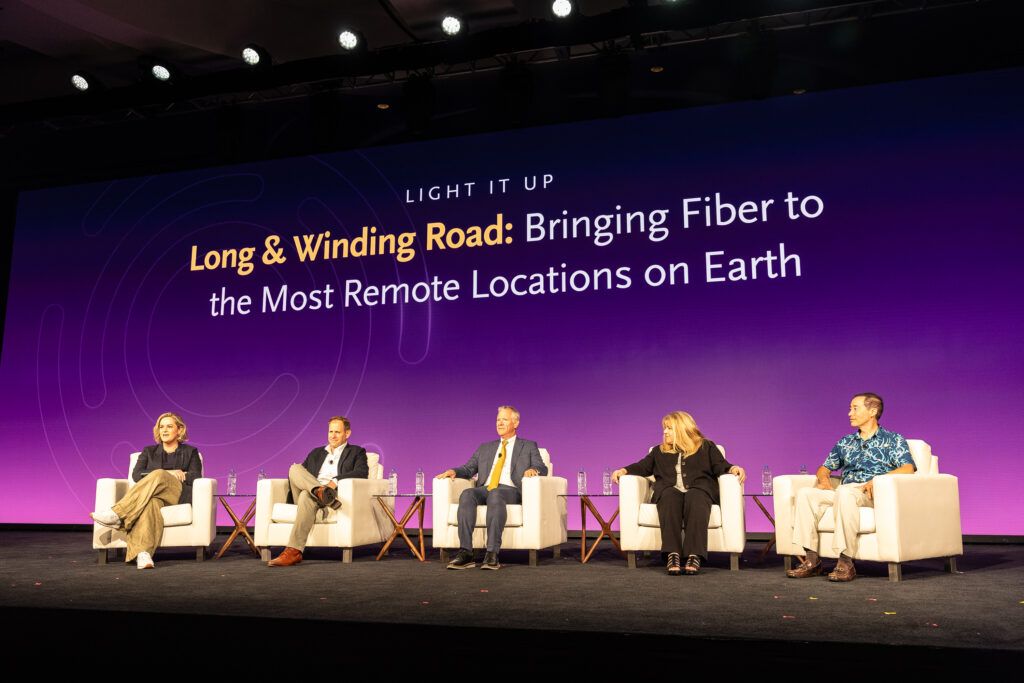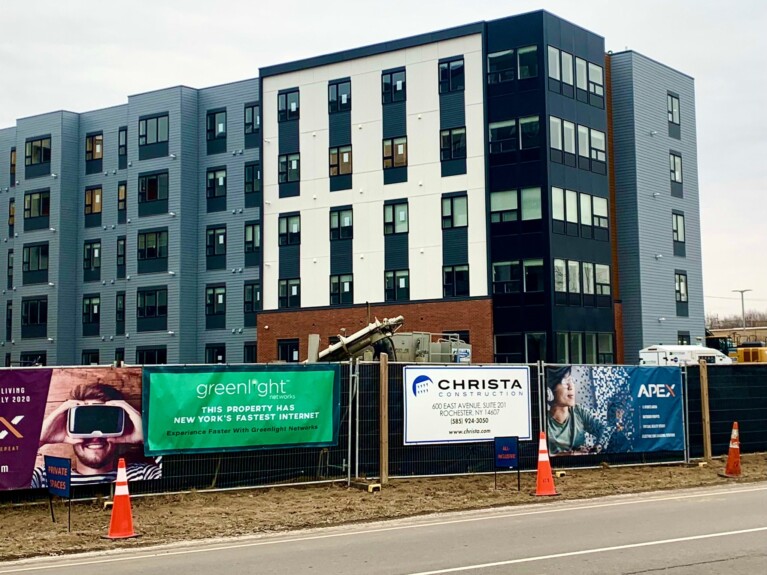Building and Rebuilding Fiber in Extreme Conditions
Author’s note: This story is based upon live presentations recorded and transcribed at Fiber Connect 2025. Quotes are best faith efforts and sometimes edited for brevity.
At the best of times, deploying fiber is a labor-intensive job that takes place with people climbing poles, digging trenches, moving dirt, and pouring concrete to put into place the mission-critical telecommunications infrastructure for today and tomorrow across North America. Distance, geography, geology, water, wildlife, and seasonal weather can all impact construction projects, while major disasters such as the 2023 Lahaina fire present immediate challenges to personnel and plant, with long-term community impacts as infrastructure is patched, repaired, and ultimately rebuilt.
Needless to say, some service providers have it much harder than others. In the pages of Fiber Forward, we’ve documented the need for humans working alongside horses and mules to pull fiber up and down mountains, noted the damage that the humble squirrel has inflicted upon innocent aerial cable throughout our beautiful land, and seen pictures of a wayward bear happily mauling the end of orange conduit during the brief Alaskan summer.
At Fiber Connect 2025, representatives from Hawaii, Maine, Texas, and Washington took the main stage for the “Deploying to Remote Areas” panel to describe their unique and ongoing challenges to connect the unconnected in their respective territories with the most reliable, durable, sustainable, and secure broadband infrastructure, opening remote communities to new and continued economic opportunities and social benefits.
When one thinks of islands, Hawaii easily comes to mind, but Maine and Washington are among numerous states that have distinct pieces of land surrounded by water with people living and working on them. “We’ve got 15 unbridged islands in the state that hold about 10,000 year-round residents, about 100,000 seasonal residents,” said Andrew Butcher, President of the Maine Connectivity Authority.”

Panelists on the “Deploy to Remote Areas” main stage keynote outline their extreme challenges in bringing broadband to remote locations across rugged terrain. From left to right – Moderator Kathryn de Wit, Manager, Broadband Research Initiative, Pew Charitable Trusts; Andrew Butcher, President, Maine Connectivity Authority; Bill Hetherington, CEO & General Manager, Bandera Electric Cooperative; Donna Hilty, Chief Operating Officer, Whidbey Telecom; Jason Thune, Vice President, Fiber Strategy and Deployment, Hawaiian Telcom. (Source: Fiber Broadband Association)
Located in the northwest corner of Washington state, Whidbey Telecom’s service includes several islands, including one privately owned property with 260 houses that require either your own boat or plane to get to. But international borders and geographic isolation make one area in particular extremely difficult to service.
“Our most remote site is Point Roberts,” said Donna Hilty, Chief Operating Officer, Whidbey Telecom. “It is located on the tip of the Tsawwassen peninsula of British Columbia, just below the 49th parallel. The United States held onto this five square mile area. To get there, you either have to have a nice sturdy boat, a private plane, or cross two international borders. The border is what makes it so remote. With the tariffs and the situation with Canada, we may have some problems getting materials over there.”
To date, Whidbey has preferred to deploy fiber underground, but Point Roberts will be an aerial build, something that the company is worried about. “As a buried system, we’re known for our reliability and that’s really the only way we can compete with people who are racing for the bottom price,” said Hilty. “We’re very concerned that when we go aerial in Point Roberts that’s going to cause a little bit of a ding [there], because the weather is extreme there. Also, we’re very proud of our views, we have beautiful mountains and the ocean. Putting up lines is not a very popular thing to do, so that’s a problem of bringing the community along with us, but they’ve been waiting for a long time.”
Hawaii presents among the most significant construction challenge of all the states due to its location. “It’s 2,500 miles away from the nearest land mass,” said Jason Thune, Vice President, Fiber Strategy and Deployment, Hawaiian Telcom. “Every island imports all their goods and to get from one island to another you have to take a plane or boat.”
And some places are more remote than others. Moloka’i, the fifth largest Hawaiian island, is only accessible by weekly barge or $200 commuter flights, making moving personnel and construction resources a non-trivial task even before arriving, since line trucks must be moved in by sea.
“It is not the cheapest place to build,” said Thune. “In some rural locations there’s a one lane road we can only go on a few hours a day and have to hike up a mountain to make it happen. We used some of our federal RDOF money to build [fiber] to that island and our take rate is well above 50%.”
Hawaiian Telcom decided to flip the script and do some of its remote locations such as Moloka’i first, a decision that delivered benefits, but required six months of advanced planning before the first truck could roll out for installations.
“It sounds counterintuitive, it’s the most expensive, it requires the most planning,” said Thune. “You can’t just drive down the street and get whatever tool you need. But if you can do your hardest ones, everything else becomes a whole lot easier. You have to think about your line trucks and cables and where to store stuff. Your equipment is going to be out of service if it gets shipped back and forth [on a barge] between [islands]. You do have to set aside way more time than you think it would take, but the good news is once you are done with it, you don’t have to worry about it anymore.”
Along with coastal islands, Texas and Maine have plenty of land, presenting different challenges for rural service providers, especially those whose fates are tied to energy.
“Our view is all of us who provide critical infrastructure, whether electric or telecom infrastructure, we’re in the data business,” said Bill Hetherington, CEO & General Manager, Bandera Electric Cooperative. “For us to be in the data business means we have to have the highest quality communications infrastructure in place. Of course, that’s fiber optics.”
Bandera needs rock-solid telecom because it is participating in Texas’ real time energy market. “Energy prices change every 15 minutes every day, so we place 96 bids a day in the market,” Hetherington stated. “It’s very challenging, but it necessitates that we have to have communications infrastructure that is extremely reliable, extremely fast, and secure.”
The electric co-op also must deal with a unique wildlife risk rarely seen within the United States. “We have people who collect giraffes, zebras, rhinoceros,” Hetherington said. “Giraffes are herd animals. You can’t have just one giraffe, you have a herd of giraffes. We’ve all had problems with squirrels eating fiber. Guess what? Giraffes actually like fiber and they have the structure to get to it. Our [fiber] is all aerial and it was a quite interesting challenge.”
Bandera is proud that they’ve been able to build out nearly all their network to date using their own funds, with some minor RDOF grants enabling them to reach the most difficult rural locations. In 2017, the co-op started installing fiber and by 2023 had almost 2,000 miles installed. Today, 82% of its over 30,000 members have access to fiber and the plan is to extend fiber to 100% of its members.
“We firmly believe if we don’t do it, these smaller communities in west Texas and some in southcentral Texas won’t exist in 10 years,” said Hetherington. “If there is no fiber infrastructure, there is no broadband infrastructure, there is no economy. The challenge is making the long-term commitment to the business investment, knowing you’re on your own and there’s nobody helping out. We don’t want outside money, we’ll just do it ourselves.”
Maine’s combination of geography and population density has it focusing on more than last mile issues. “Maine represents a population of about 1.4 million people in a state footprint that is about three quarters the size of Pennsylvania,” said Butcher. “For us as a state, as we look at expanding our middle mile and look to ensure last mile connectivity, we will be looking for partners as we operate, maintain, and expand upon the use of the new middle mile network. We are actively looking at partners to help support how we can address our wireless cellular needs with fiber as a key backhaul component.”
But connecting the unconnected also means reconnecting the disconnected, as Hawaiian Telcom and parent altafiber faced in the aftermath of the catastrophic Lahaina fire. On August 8 and 9, 2023, fire swept across the Lahaina area on the island of Maui, driven by high winds from offshore Hurricane Dora. The conflagration overwhelmed the city and local infrastructure, resulting in 101 fatalities and literally burning the town to the ground.
“The fire was the deadliest U.S. wildfire in the last century,” said Ron Beerman, Chief Network Officer, altafiber. “It leveled 90% of the area. 12,000 residents were displaced, 3,000 holdings completely destroyed. We have a central office in Lahaina. Amazing it was still standing.”
While the central office survived, with the HVAC, generator, switch, and all its core network equipment intact and operating as expected, all the cabling running into the CO was melted or burned. Still, the survival of the CO provided a base of operations for telecommunications recovery, first as a central hub for temporary mobile cell trucks to provide power and later to provide backhaul connectivity once fiber was restored.
“Our Incident Response Teams jumped in obviously immediately as the fire was actually happening,” said Beerman. “One of the things [they] do is start to prioritize. What is our next step? What are the immediate things that need to be taken care of?”

Ron Beerman, altafiber Chief Network Officer, discusses the many challenges rebuilding Lahaina telecommunications infrastructure after the fire of August 8-9, 2003. (Source: Fiber Broadband Association)
Among those priorities were providing Wi-Fi and phone services to the emergency shelters brought up to house thousands of dislocated residents, charging stations for phones and other devices, and restoring service to customers affected by the fire. It was necessary to clear the roads and remove damaged infrastructure before rebuilding could start, including tearing out around 30 miles of damaged copper and 50 damaged poles; other poles had simply disintegrated into ash, leaving nails and other metals in their debris that were hazards to telecom works and vehicles. Temporary fiber was laid across roads and streets until more permanent arrangements could be made.
“By August 10, two days later, we had 10,000 customers back in service,” said Beerman. “About a week later, we had the Maui Police Department and the Lahaina Civic Center fully back. Those were critical efforts in terms of the recovery in general.”
Initial cleanup and repair included pulling out 30 miles of damaged copper and taking down 50 damaged telephone poles, followed by putting up replacement poles and deploying 20 miles of fiber to connect the central office to the rest of network. For workers on the ground, ash presented a significant hazard in the early days, requiring technicians to be carefully fitted with respirators to avoid inhaling toxic substances stirred up by bulldozers and other equipment working to clear the streets and roads.
“In Hawaii, beards, mustaches, and goatees are a big thing, part of the identity of a lot of who these technicians are,” said Beerman. “And the fact these guys shaved clean, that was a badge of honor. That meant they were in the field, they were helping, and they were proud to do it.”
Two years later, homes and businesses are starting to be rebuilt, with new challenges being brought with new construction. Discussions on rebuilding roads led into other discussions on adding evacuation routes. Putting everything underground didn’t go as expected, so Hawaiian Telcom is simply putting fiber on the new poles the electric company has deployed.
“However, there are key differences to our response,” said Beerman. “It’s fiber first this time. We’re not laying copper into Lahaina. We’re rebuilding with fiber only. We’ve added redundancy and resiliency, and we’re committed to the fiber first approach in terms of how we respond. We recognize we are not just rebuilding networks, we’re rebuilding hope.”





